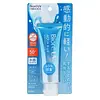What's inside
What's inside
 Key Ingredients
Key Ingredients

 Benefits
Benefits

 Concerns
Concerns

 Ingredients Side-by-side
Ingredients Side-by-side

Water
Skin ConditioningEthylhexyl Methoxycinnamate
UV AbsorberCyclotetrasiloxane
EmollientCyclopentasiloxane
EmollientCetyl Alcohol
EmollientGlyceryl Stearate
EmollientCeteareth-20
CleansingCeteareth-12
EmulsifyingCetearyl Alcohol
EmollientCetyl Palmitate
EmollientButyl Methoxydibenzoylmethane
UV AbsorberOctocrylene
UV AbsorberBenzyl Alcohol
PerfumingGlyceryl Caprylate
EmollientGlyceryl Undecylenate
EmollientButyrospermum Parkii Butter
Skin ConditioningC12-15 Alkyl Benzoate
AntimicrobialTitanium Dioxide
Cosmetic ColorantAluminum Hydroxide
EmollientDimethicone/Methicone Copolymer
Sorbitan Palmitate
EmulsifyingSorbitan Olivate
EmulsifyingCarbomer
Emulsion StabilisingTriethanolamine
BufferingBisabolol
MaskingPanthenol
Skin ConditioningSodium Polyacrylate
AbsorbentTocopheryl Acetate
AntioxidantCitric Acid
BufferingTetrasodium EDTA
Benzylidene Dimethoxydimethylindanone
Skin ProtectingWater, Ethylhexyl Methoxycinnamate, Cyclotetrasiloxane, Cyclopentasiloxane, Cetyl Alcohol, Glyceryl Stearate, Ceteareth-20, Ceteareth-12, Cetearyl Alcohol, Cetyl Palmitate, Butyl Methoxydibenzoylmethane, Octocrylene, Benzyl Alcohol, Glyceryl Caprylate, Glyceryl Undecylenate, Butyrospermum Parkii Butter, C12-15 Alkyl Benzoate, Titanium Dioxide, Aluminum Hydroxide, Dimethicone/Methicone Copolymer, Sorbitan Palmitate, Sorbitan Olivate, Carbomer, Triethanolamine, Bisabolol, Panthenol, Sodium Polyacrylate, Tocopheryl Acetate, Citric Acid, Tetrasodium EDTA, Benzylidene Dimethoxydimethylindanone
Water
Skin ConditioningAlcohol Denat.
AntimicrobialEthylhexyl Methoxycinnamate
UV AbsorberEthylhexyl Triazone
UV AbsorberIsopropyl Palmitate
EmollientLauryl Methacrylate/Sodium Methacrylate Crosspolymer
Diethylamino Hydroxybenzoyl Hexyl Benzoate
UV FilterHydrogenated Polyisobutene
EmollientBis-Ethylhexyloxyphenol Methoxyphenyl Triazine
Skin ConditioningPalmitic Acid
EmollientDextrin
AbsorbentButylene Glycol
HumectantXylitol
HumectantAcrylates/C10-30 Alkyl Acrylate Crosspolymer
Emulsion StabilisingDimethicone
EmollientC12-15 Alkyl Benzoate
AntimicrobialGlycerin
HumectantGlyceryl Stearate
EmollientPropanediol
SolventGlyceryl Behenate
EmollientVinyl Dimethicone/Methicone Silsesquioxane Crosspolymer
Cetearyl Alcohol
EmollientAgar
MaskingSorbitan Distearate
EmollientIsoceteth-20
EmulsifyingPolyvinyl Alcohol
Polyvinylalcohol Crosspolymer
Stearoyl Glutamic Acid
CleansingArginine
MaskingPotassium Hydroxide
BufferingSodium Hydroxide
BufferingRoyal Jelly Extract
Skin ConditioningSodium Hyaluronate
HumectantPhenoxyethanol
PreservativeDisodium EDTA
BHT
AntioxidantParfum
MaskingWater, Alcohol Denat., Ethylhexyl Methoxycinnamate, Ethylhexyl Triazone, Isopropyl Palmitate, Lauryl Methacrylate/Sodium Methacrylate Crosspolymer, Diethylamino Hydroxybenzoyl Hexyl Benzoate, Hydrogenated Polyisobutene, Bis-Ethylhexyloxyphenol Methoxyphenyl Triazine, Palmitic Acid, Dextrin, Butylene Glycol, Xylitol, Acrylates/C10-30 Alkyl Acrylate Crosspolymer, Dimethicone, C12-15 Alkyl Benzoate, Glycerin, Glyceryl Stearate, Propanediol, Glyceryl Behenate, Vinyl Dimethicone/Methicone Silsesquioxane Crosspolymer, Cetearyl Alcohol, Agar, Sorbitan Distearate, Isoceteth-20, Polyvinyl Alcohol, Polyvinylalcohol Crosspolymer, Stearoyl Glutamic Acid, Arginine, Potassium Hydroxide, Sodium Hydroxide, Royal Jelly Extract, Sodium Hyaluronate, Phenoxyethanol, Disodium EDTA, BHT, Parfum
 Reviews
Reviews

Ingredients Explained
These ingredients are found in both products.
Ingredients higher up in an ingredient list are typically present in a larger amount.
C12-15 Alkyl Benzoate is made up of Benzoic Acid and long chain alcohols. It has a low molecular weight.
C12-15 Alkyl Benzoate is an emollient and texture enhancer. Due to its solubility, it is often used in sunscreens to help evenly distribute active ingredients.
As an emollient, C12-15 Alkyl Benzoate helps soften and hydrate your skin. Emollients create a film on your skin that traps moisture within.
This ingredient has been reported to cause eye irritation.
Learn more about C12-15 Alkyl BenzoateCetearyl alcohol is a mixture of two fatty alcohols: cetyl alcohol and stearyl alcohol. It is mainly used as an emulsifier. Emulsifiers help prevent the separation of oils and products. Due to its composition, it can also be used to thicken a product or help create foam.
Cetearyl alcohol is an emollient. Emollients help soothe and hydrate the skin by trapping moisture.
Studies show Cetearyl alcohol is non-toxic and non-irritating. The FDA allows products labeled "alcohol-free" to have fatty alcohols.
This ingredient is usually derived from plant oils such as palm, vegetable, or coconut oils. There is debate on whether this ingredient will cause acne.
Due to the fatty acid base, this ingredient may not be Malassezia folliculitis safe.
Learn more about Cetearyl AlcoholEthylhexyl Methoxycinnamate is an organic compound that provides UVB protection. It often goes by the more common name of octinoxate. It is created from methoxycinnamic acid and 2-ethylhexanol.
Ethylhexyl Methoxycinnamate absorbs UVB rays with wavelengths between 280-320 nm. UV absorbers protect your skin by using chemical reactions to convert UV rays into heat and energy.
UVB (290-320 nm) rays emit more energy than UVA rays. They are capable of damaging DNA, causing sunburns and are thought to be linked to skin cancer.
The state of Hawaii has banned sunscreens containing octinoxate due to its potential impact on coral reefs. More research is needed to bridge gaps in this research. The European Union allows higher levels of octinoxate in sunscreens than the US and Australia.
Ethylhexyl Methoxycinnamate is oil soluble. It is not stable and may lose efficacy when exposed to sunlight.
Learn more about Ethylhexyl MethoxycinnamateGlyceryl Stearate is a mix of glycerin and stearic acid.
It is used to stabilize the mixing of water and oil ingredients. By preventing these ingredients from separating, it can help elongate shelf life. It can also help thicken the product's texture.
As an emollient, it helps soften skin and supports barrier-replenishing ingredients.
In cosmetics, Glyceryl Stearate is often made from vegetable oils or synthetically produced.
This ingredient may not be fungal-acne safe
Fun fact: The human body also creates Glyceryl Stearate naturally.
Learn more about Glyceryl StearateWater. It's the most common cosmetic ingredient of all. You'll usually see it at the top of ingredient lists, meaning that it makes up the largest part of the product.
So why is it so popular? Water most often acts as a solvent - this means that it helps dissolve other ingredients into the formulation.
You'll also recognize water as that liquid we all need to stay alive. If you see this, drink a glass of water. Stay hydrated!
Learn more about Water